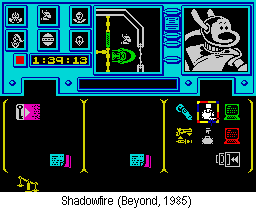|

By Lloyd Mangram
June
1985
Issue 17
|
|
Ocean's
Frankie Goes To Hollywood was the obvious cover
choice for the month; the band members didn't appear
in the game, but Oliver was determined they would on
the cover. For his departure point he picked the kitsch
theme from the Power Of Love promo video where
they all appear as gilded cherubs around an ornate picture
frame. It was then a question of fitting in some of
the elements of the game. This, perhaps the most unusual
CRASH cover, was also the most accomplished representation
of a particular game Oliver had done to date.
|
Once again, we took a little dig at Your Spectrum on the
cover flash, this time in a reference to computer repair shops:
'Is Your Spectrum fit for the Scrapheap?' But the real issue
of the month was Denton Designs, the talented group of programmers
who had started at the old Imagine. Now, part-financed by
Ocean and contractually supported by Beyond, they had formed
a nucleus of games designers and programmers. Denton Designs
was the most visible tip of a new development in the games-software
industry.
The back-bedroom days were over; larger and more financially
powerful companies like Ocean, US Gold, Argus and British
Telecom were taking over smaller independents who had survived
from the pioneering days. There was a more professional approach.
Programmers no longer wanted to bother with marketing and
distribution, programming was their strength, and so a number
of development groups were springing up, people who didn't
want to spend time selling their work but who also didn't
want to be part of a large corporation. They were the new
software contractors, and none received as much publicity
as Denton Designs.
 Gift
From The Gods for Ocean was Denton Designs's first released
game; in this issue we extensively previewed Frankie Goes
To Hollywood, but it was Shadowfire for Beyond,
the game Denton Designs first contracted for, which was reviewed.
Looking back, Shadowfire actually lacked content, but
its shallow qualities were well disguised by the novel icon
presentation. Pete Cooke's Ski Star 2000 may have been
the first game to use icons, but Shadowfire was the first
to base the entire gameplay and control on these graphic devices. Gift
From The Gods for Ocean was Denton Designs's first released
game; in this issue we extensively previewed Frankie Goes
To Hollywood, but it was Shadowfire for Beyond,
the game Denton Designs first contracted for, which was reviewed.
Looking back, Shadowfire actually lacked content, but
its shallow qualities were well disguised by the novel icon
presentation. Pete Cooke's Ski Star 2000 may have been
the first game to use icons, but Shadowfire was the first
to base the entire gameplay and control on these graphic devices.
In fact, Robin Candy found Shadowfire so easy he'd
completed it on the second day after its arrival and was able
to prove the point in this issue's Playing Tips!
Much more enjoyably frustrating, though decidedly without
the evident programming cleverness of Shadowfire, was
US Gold's Tapper, a beer-swilling experience of keeping
bar customers satisfied that defied everyone's arcade abilities.
It just made a Smash because it was irresistible!
If there had been any doubt the month before about the demise
of sports simulations as a genre (and history has certainly
proved it to be an ill-founded doubt), then New Generation's
endorsed Jonah Barrington's Squash helped put fears
on the shelf, though few reviewers thought the presentation
had advanced much on Psion's Match Point.
What it did have was synthesized speech for the scoring (Death
Star Interceptor had also had a go at that), which prompted
Matthew, in a rare reappearance as a reviewer, to say it was
difficult to hear without his 'famdabidozy-super-blaster radio
amplifier' - a precursor of the 128, no doubt.
Derek had a couple of Smashes in Witch's Cauldron
from Mikro-Gen, an adventure using Wally Week-style graphics,
and the excellent Runestone from Games Workshop, whose
graphics showed it wasn't only Mike Singleton who could provide
'landscaping' techniques.
At this moment a crisis arose. Though Newsfield's new Commodore
title ZZAP! 64 had taken off extremely well, production problems
were emerging with its editorial base being far away in Yeovil.
Chris Anderson had provided a marvellous product, but he didn't
want to move up to Ludlow, whereas Newsfield's management
wanted the magazine in its own premises. There was a head-on
clash which resulted in Chris leaving the company and the
ZZAP! team arriving in Ludlow in the middle of June as we
started on the July issue. We all had to move round to make
room . . .
|